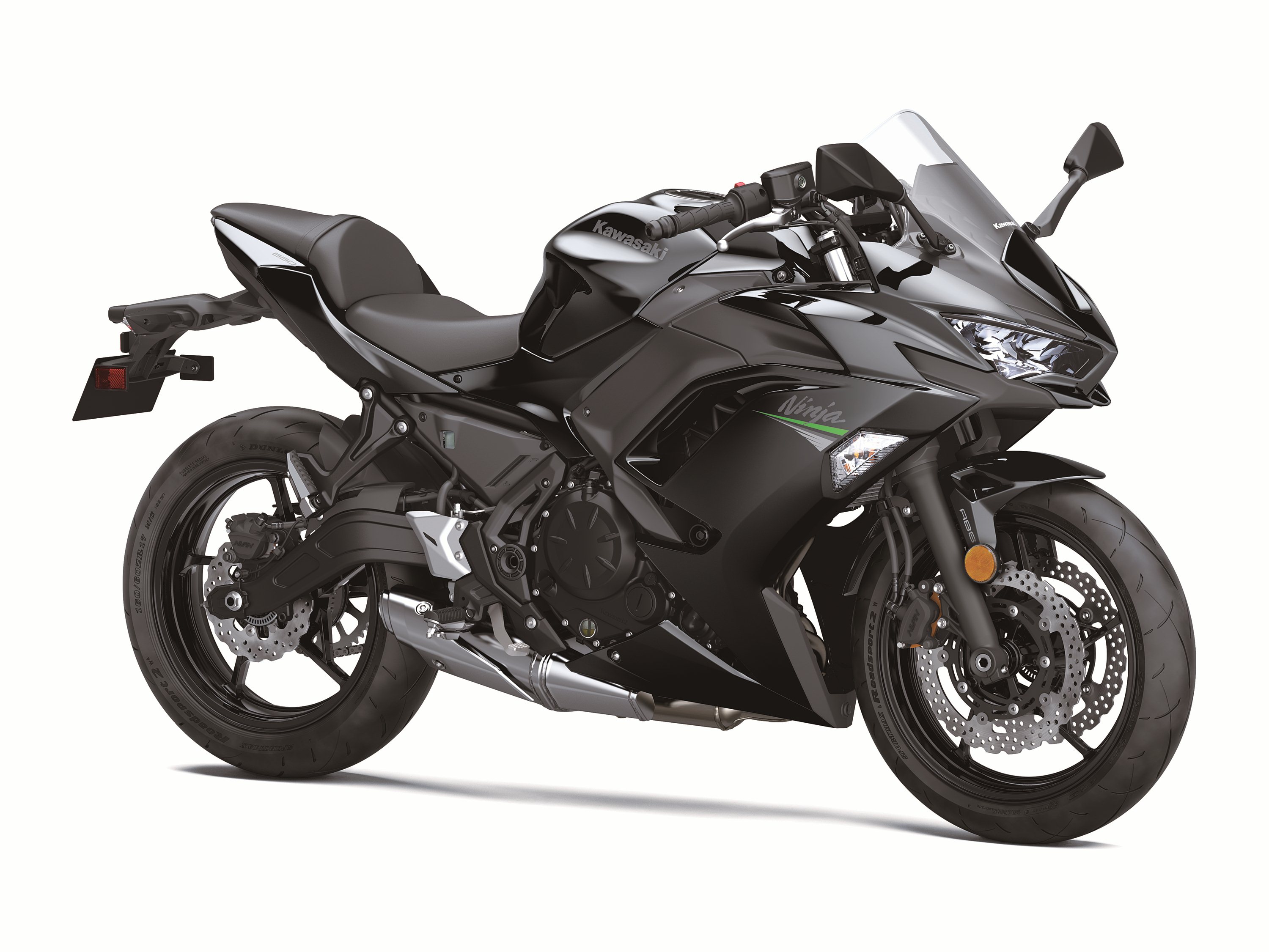
Kawasaki’s budget-priced, middleweight Ninja 650 Sport model receives several updates for the 2020 model year. These include new LED headlights, color TFT instrumentation, styling changes and new, upgraded rubber (Dunlop Roadsport 2 tires).
Here are some photos and the press release from Kawasaki:
Kawasaki is no stranger to the pursuit of performance, excitement, and all out fun, and nothing embodies this philosophy more than the new 2020 Ninja® 650 motorcycle. It’s one of the most well balanced motorcycles Kawasaki has produced, blending the fun and easy handling with optimal engine and chassis performance, and the legendary sleek Kawasaki Ninja® styling. For 2020, the new Kawasaki Ninja 650 features the tried and true 650cc parallel twin cylinder power plant and new styling, as well as a high-performance chassis and a full suite of state of the art advanced rider support features.
What makes the Ninja 650 one of the most well-balanced and exciting motorcycles for a daily commute or an afternoon out on some tight, winding, back roads is the strong parallel twin engine and sporty lightweight chassis, which delivers smooth and agile handling.
Developed to offer the ideal blend of sporty performance and everyday versatility for a wide range of riders, the Ninja 650 keeps the good times rolling. The Ninja 650 features sharp, new styling, new LED headlights, TFT color display, smartphone connectivity via RIDEOLOGY THE APP, as well as several other new updates.
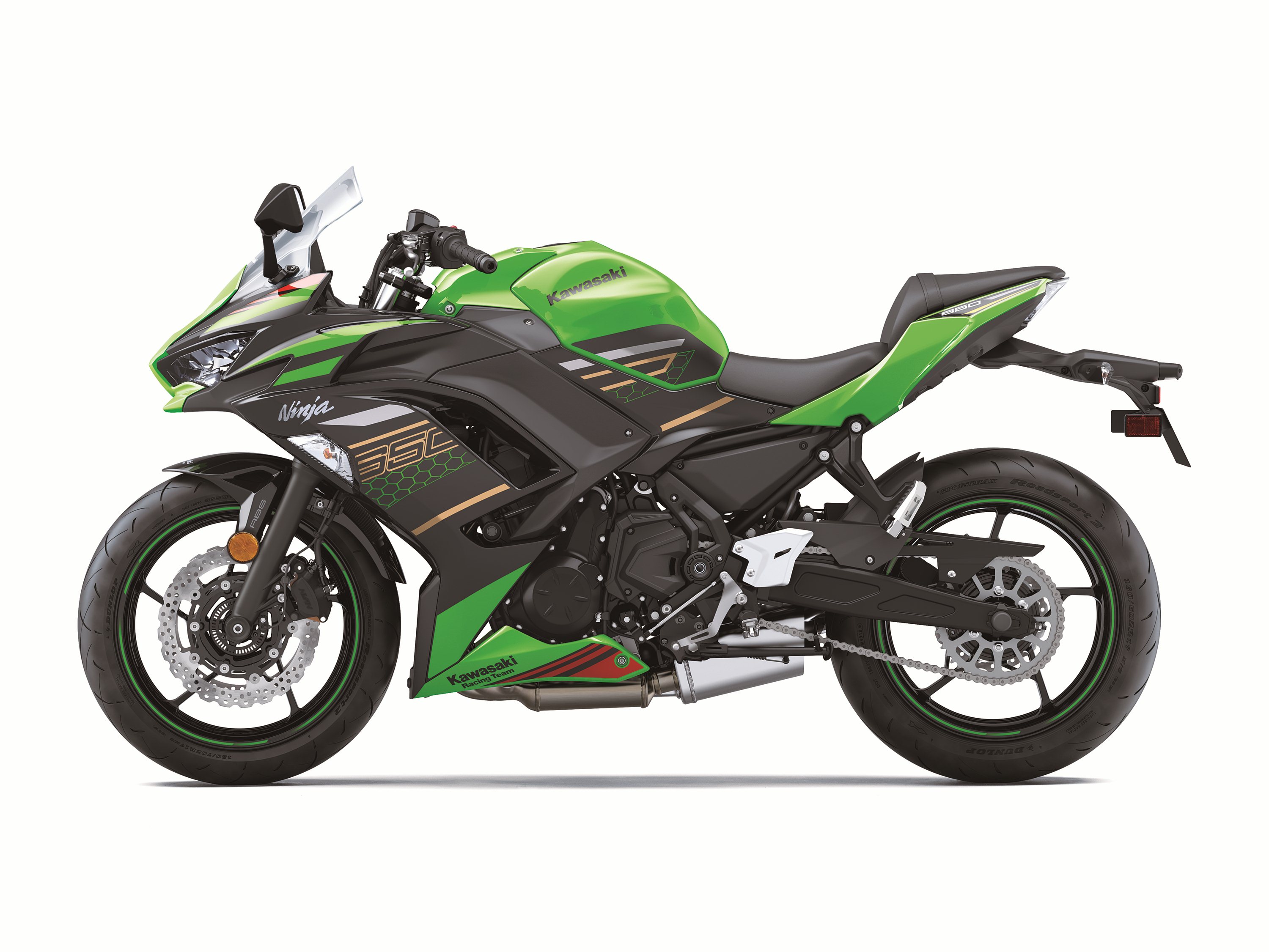
Highlights of the 2020 NINJA 650
- NEW Styling with Twin LED Headlights
- NEW TFT Color Instrumentation
- NEW Smartphone Connectivity via RIDEOLOGY THE APP
- NEW Dunlop Sportmax Roadsport 2 Tires
- NEW Upper Cowl, Windshield, and Passenger Seat
Styling
The sharp new styling of the Ninja 650 gives the motorcycle an even sportier appearance and even stronger Ninja family appearance. Its sleek and sporty design catches the attention of new and seasoned riders alike.
The new upper cowl is wider, with more sleek contours that help create the sporty appearance. Prioritizing a sportier look, the redesigned windshield is now lower and flush-fit with the upper cowl. It’s set at a more upright angle to offer the rider increased wind protection. Another new styling feature to the Ninja 650 is the addition of the twin LED headlights, each featuring low and high beam as well as a position lamp. To further enhance the image of the motorcycle fairing bolts have been replaced by hooks, which create a clean, smooth surface for a high-class appeal.
Increased passenger comfort also complements the new styling of the Ninja 650, with a thicker and wider urethane passenger seat.
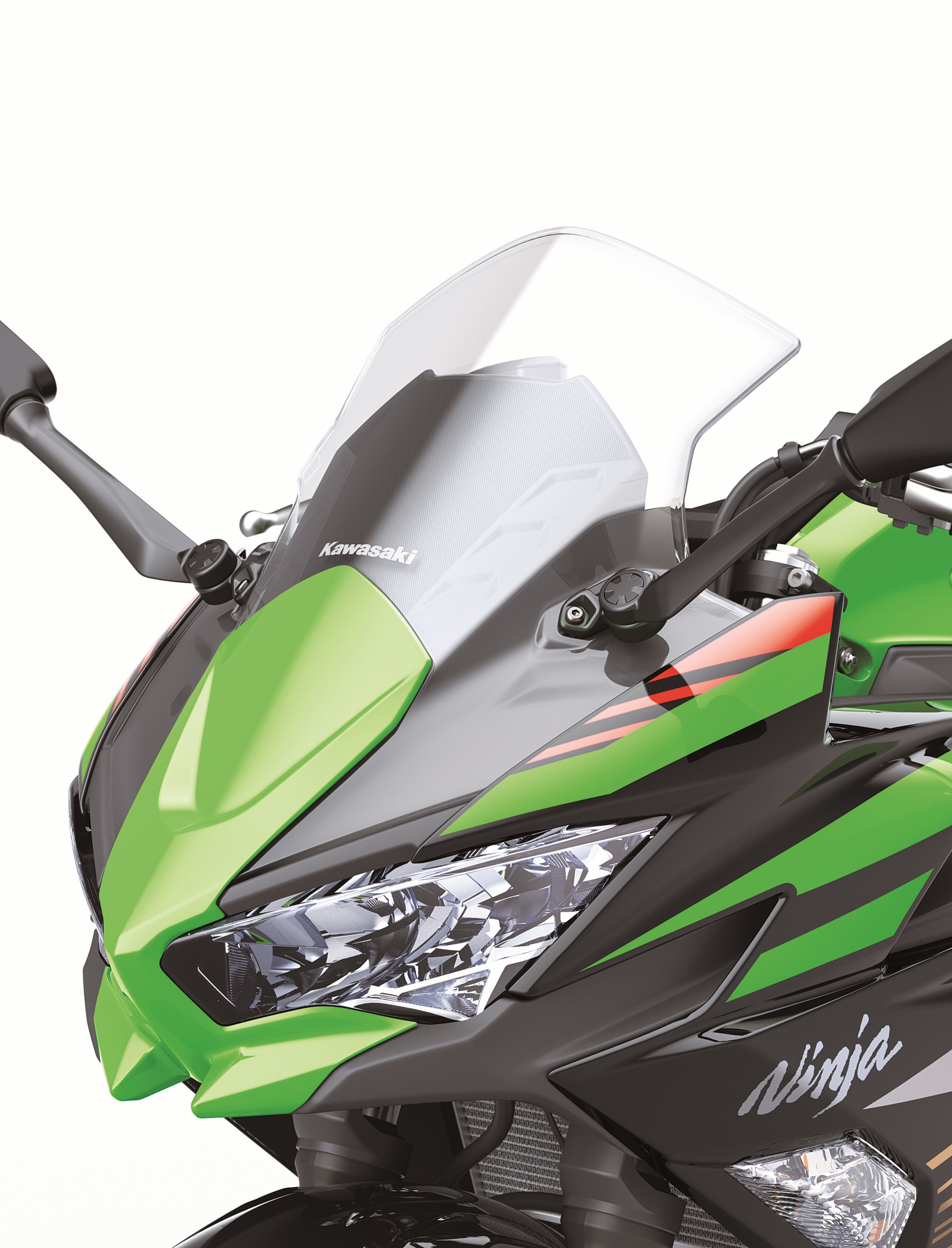
TFT Color Instrumentation
The new 4.3” all-digital TFT color instrumentation– a Kawasaki first in the 650cc class – gives the cockpit of the Ninja 650 motorcycle a high-tech, high-grade appearance. The new meter also offers additional features.
The full color display features TFT (thin-film transistor) technology, which delivers a high level of visibility. The screen’s background color is selectable (black or white), and screen brightness adjusts automatically to suit available light. Display functions include: digital speedometer, digital bar-style tachometer, gear position indicator, shift lamp, fuel gauge, odometer, dual trip meters, current and average fuel consumption, remaining range, average speed, total time, coolant temperature, clock, battery voltage, Kawasaki service reminder, oil change reminder, and Economical Riding Indicator.
Smartphone Connectivity
Another Kawasaki first for the middleweight Ninja® line of motorcycles is the addition of Smartphone Connectivity. A chip built into the instrument panel enables riders to connect to their motorcycle wirelessly. Using RIDEOLOGY THE APP, a number of instrument functions can be accessed, logged, and reviewed contributing to an enhanced motorcycling experience. The following information can be viewed:
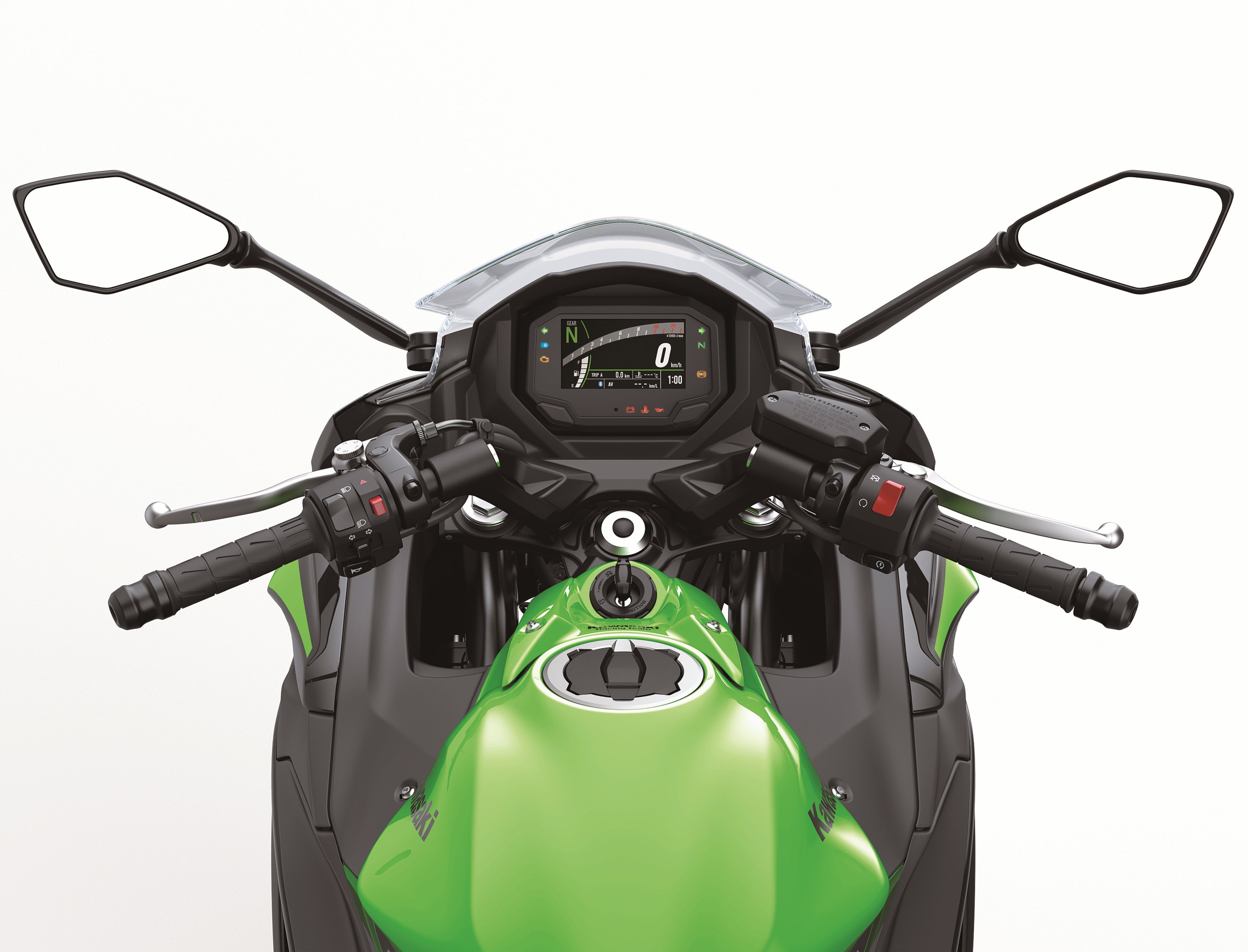
1. Vehicle Info
- Check latest status update
2. Riding Log
- Can be logged in detail, and played back for review
- Route, Distance & Time traveled can be logged for review
- Riding conditions can be recorded in detail
3. Telephone Notifications
- Provides a notification on dash when a call or mail is received by smartphone
4. Tuning
- General instrument display setting changes can be made on your smartphone
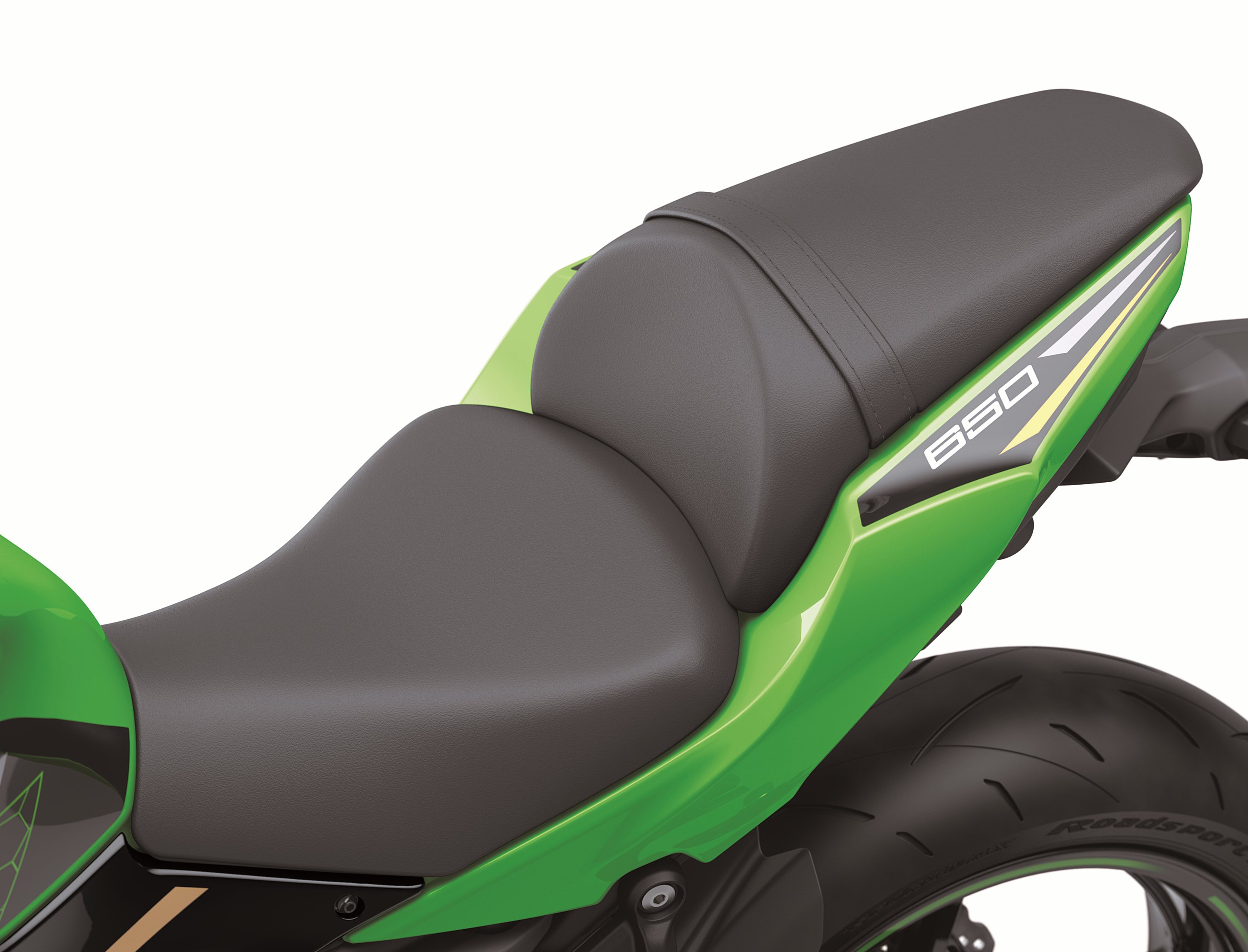
The app can also be used when away from the motorcycle. When riding (with the app ON), the bike and smartphone are always connected and riding log data is being recorded by the app. After your ride, the latest riding information is stored by the app and may be viewed on the smartphone. Any changes made via the app while the engine is off, or while out of range, will be implemented as soon as the ignition is turned on and the smartphone is in range with the app ON.
Tires
Enhancing performance on the 2020 Ninja 650 are the new Dunlop Sportmax Roadsport 2 tires, which help to improve upon the lightweight and nimble handling of the Ninja 650.
Accessories
Kawasaki offers a full line of Kawasaki Genuine Accessories (KGA) including a larger windshield, helmet lock, TFT meter protection film, Ergo-Fit™ high seat (+30 mm), oil filler cap, tank pad, pillion seat cover, semi-soft panniers, top case, DC outlet (50 W), , U-lock, radiator screen, frame sliders, tank pad, and knee pads.
Colors
The 2020 Kawasaki Ninja 650 is available in:
Lime Green / Ebony (Kawasaki Racing Team KRT)
Metallic Spark Black
Pearl Blizzard White
MSRP
Starting at $7,399 (Non-ABS)
See more of MD’s great photography:






My God, that is so UGLY. Did a transformer design it? Kawasaki, please go hire a couple of Italians and let them do their magic. Seriously.
I agree about the “ugly”. Why do most Japanese bikes look like insects?
too many nooks
Kawasaki offers demo rides on both the Ninja 400 and Ninja 650. Details and locations are available on their website under “events”. You also get a coupon for $500 off 500cc and larger bikes, and $250 off under 500cc. Test rides are the best way to understand which bike is best for you. Test Ride before you decide!
I love the 650. I would like to have the new lighter version but the styling on my old 07 is so much more to my liking.
I infer that it’s the same bike underneath, engine, suspension. A used 2015 might be a smart buy.
The entire Z/Ninja 650 platform was completely revised for the 2017 model year.
Now I have go get a smart phone?
The description screams “Computer Bike”.
The tail section says “Only Ballerinas Need Apply”
My soul says “Leave the electronic devices at home and feel nature blowing on your heart”
That would be my reason for riding. Not computer bells and whistles.
It’s great you have choice then. Plenty of new (and used) bikes that offer the classic experience your soul cries out for. I like the new look (in white most of all).
The number of old fart Luddites on this site is amazing. lol
Thank you !
There is absolutely NOTHING unique about its looks, exactly the same as all the angular heterogeneous sport bikes made for the last 3 decades. This engine does vibe right at freeway speed, despite all the satisfied owners. Time to go back to smooth as aerodynamic and put into this 650, a 270 crank. I think it is the lower limit displacement that can work with a 270.
In my opinion this popular edge styling is now killing interest in younger would be riders because it is so common.
“fairing bolts have been replaced by hooks, which create a clean, smooth surface for a high-class appeal.“
Does this mean they added plastic snap features to reduce assembly costs?
Remember when “New And Improved” MAY have actually meant it? Pepperidge Farm remembers.
On paper, this is yet another nice new bike. But the styling (like many others) leaves me wondering when they will remember Less is More.. So many panels, bumps, flares, cutouts… so busy.
I washed and detailed the bike last weekend, took all of an hour or so (not going crazy on the undercarriage, it ain’t that pretty!).
This bike would take a forever to wash and wax all those busy bits!
Love the site, BTW!!
i rode a 2009 ninja 650 for 5-6 yrs. loved it bunches.
if i were able to ride now, i’d fer shur grab the 400z.
and y’know every bike is not going to meet everyone’s desires or expectations.
The bones of this bike (engine, transmission, frame) were designed 15 years ago. A test ride confirms this, as the bike feels dated. Conversely, the Ninja 400 is an all-new design in 2018, and feels that way too. The combination of new design, and reduced weight (20+ pounds vs the Ninja 300) makes the 400 feel like a hot rod. The 650 feels lethargic. As an added bonus, the 400 Ninja is $2500 cheaper. I’ve been riding for 30+ years, and the 400 Ninja thrills me. The 650 not so much. The 650 needs a complete redesign, or its destined to compete on price.
Thank you for that synopsis. I was torn between this and the 400 but I think I’m now leaning 400. Many thanks.
The 400 seems dated to me. I can tell the design is two years old. The 650 is a different bike so it will feel different from the 400. If you didn’t know it was designed 15 years ago, you would just know that’s how the 650 feels.
The 650 engine, while largely the same, was completely revised a couple of years ago. The frame is completely different from the original and the bike is 40 lbs. lighter overall. Your opinion of the riding experience is what it is, but this isn’t the same bike they introduced 15 years ago.
Kawasaki 650’s are really nice bikes. I really liked my Z650, unfortunately I had to trade it in on a car. There was some buzz in the handlebars but it wasn’t bothersome. I like what they did with this one.
The Ninja 650 and Z650 offer up a great package for the money in my opinion. The bikes look good, and I’ve always been a fan of Kawasaki’s little 650, probably my favorite engine from the budget midsize world.
What a smart street bike. I’ve always liked this bike; fun, affordable, one that new riders won’t outgrow and experienced riders appreciate. I just wish that Kawasaki (and other manufacturers too) would learn from European manufacturers and offer an upgrade version with better suspension and brakes. $7,399 is a good starting price, but when I buy bikes like this I always find myself investing a lot of money in the parts that the factory pulled out of the budget bin. Still…I like this bike as well as the 400.
I’ve always been wary of Kawasaki’s old 180 parallel twin, even though I’ve never ridden anything bigger than their 300. I imagine the 650 being buzzy and unpleasant at the RPMs where it’s making any power, but again, I’ve never ridden it. What’s it like to use?
I had the same engine in my 650 Versys. While you can feel it’s an internal combustion engine working underneath you, it’s not buzzy or vibey at all.
It has good torque and for a 650 you’d be surprised how fast it gets you up to high speed and more than enough for comfortable 75 mph cruising.
Take one for a demo ride. They get great gas mileage as well no matter how hard you hoon it.
When I rode a Versys twin some years ago, the motor seemed so busy I thought the tacho must be reading low! For a touring bike, I thought the motor was much too frenetic-sounding. Maybe they have refined it?
In parallel twins, I much prefer the 270 degree crank over the 180. Curiously, Yamaha chose the 180 for the MT-03 despite touting the benefits of the “Cross Plane” 270 design in the MT-07.
I borrowed a friend’s Ninja 650 for a week as he tried my Ducati. I thought the engine was sweet and “punchy”. It did everything well (except some asymmetrical flex in the rear) and didn’t feel buzzy at all.
“I just wish that Kawasaki (and other manufacturers too) would learn from European manufacturers and offer an upgrade version with better suspension and brakes”
I think the reason they don’t is because the Japanese makes are full-line suppliers. Each model has to reach as broad an audience as possible, at the most competitive price. I guess there aren’t enough guys like us who would gladly pay $500 more up-front for good fork and shock valving instead of paying $1,000+ for fixing it after purchase.
Bingo! It’s all about marketing and product placement within their segment.
Dave could be wrong but it seems for the Euro models the price between the std models and those with upgraded suspensions, the R models so to speak, have a much larger disparity of price than $500
You are right. My $500 is a number I pulled out of a hat- a guess at what an adjustable rear shock and cartridge fork appropriate for a bike like this would cost.
The Euro bikes are premium bikes at base level and so the “R” models usually get the Ohlins and Brembo treatment, adding $2,500 or more to the price of an already fairly expensive bike.